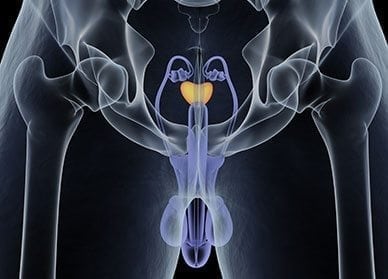The prostate gland is a small, walnut-sized organ in men that surrounds the urethra, which is the tube that carries urine out of the bladder. The main function of the prostate gland is to secrete a fluid that constitutes about 10-30 percent of semen.
The prostate is significantly prone to disease. The most common prostate problems include benign prostatic hyperplasia, prostate cancer and prostatitis. Up to 80 percent of men will experience some type of prostate problem within their lifetime. Although prostate problems mainly affect older men, younger men can still be affected. Being informed about the symptoms and risk factors of prostate conditions will help you gain better control of your sexual health.
Benign Prostatic Hyperplasia
 The prostate naturally enlarges after a man has passed middle age. When the prostate enlarges too much and causes symptoms, this condition is known as benign prostatic hyperplasia, or simply BPH. The symptoms consist of urinary problems, and these symptoms are due to the enlarged prostate putting pressure on the urethra. A sufficiently enlarged prostate can also put significant pressure on the bladder itself.
The prostate naturally enlarges after a man has passed middle age. When the prostate enlarges too much and causes symptoms, this condition is known as benign prostatic hyperplasia, or simply BPH. The symptoms consist of urinary problems, and these symptoms are due to the enlarged prostate putting pressure on the urethra. A sufficiently enlarged prostate can also put significant pressure on the bladder itself.
Here are some telling symptoms that indicate you likely have BPH:
- difficulty beginning urination
- feeling unable to completely empty your bladder
- frequent urge to urinate
- painful urination
- sudden urges to urinate
- waking up at night to urinate
- weak urine flow
Aside from age, other risk factors for benign prostatic hyperplasia include family history of the condition, diabetes, heart disease and being overweight or obese.
Kegel Exercises for Prostate Health
Kegel exercises can be very useful for treating urinary symptoms caused by BPH, as well as similar urinary symptoms caused by other conditions. These exercises are designed to strengthen the pelvic floor muscles. To do Kegel exercises:
- Locate your pelvic floor muscles. Imagine that you are stopping or intentionally holding your urine flow. The muscles that do this are pelvic floor muscles.
- Tighten and hold those muscles for five seconds, then relax.
- Aim for 10 to 20 repetitions of step two, three to four times a day.
You may not be able to do 10 to 20 Kegels at a time. If this is the case, just slowly work your way up. It can take around six weeks for your pelvic floor muscles to become noticeably strengthened.
When doing Kegels, do not hold your breath, push outward or down, or tighten the muscles in your stomach or buttocks. If you have difficulty locating your pelvic floor muscles or have other questions about Kegels, ask your urologist.
Other Natural Options for Prostate Health
Some men see success with natural supplements for relieving symptoms of BPH such as saw palmetto and stinging nettle. A healthy lifestyle, including a plant-rich diet and regular exercise, can also reduce your risk of developing BPH. If you have severe BPH, further intervention may be required, such as a surgical procedure.
If you have symptoms of BPH, talk to your doctor. You should not assume that these symptoms are caused by a benign condition. The same symptoms present in BPH can also be caused by more serious medical problems, such as neurological conditions and prostate cancer.
Prostate Cancer
 Nearly 12 percent of men will be diagnosed with prostate cancer within their lifetime. The symptoms of prostate cancer can be very similar to those of BPH. Or, there may be no symptoms. For this reason, it is crucial that men get tested for this disease every year, starting at age 50. Some men, such as African-Americans and those with a family history of cancer, should start their annual testing at age 45. Reduce your risk of prostate cancer by:
Nearly 12 percent of men will be diagnosed with prostate cancer within their lifetime. The symptoms of prostate cancer can be very similar to those of BPH. Or, there may be no symptoms. For this reason, it is crucial that men get tested for this disease every year, starting at age 50. Some men, such as African-Americans and those with a family history of cancer, should start their annual testing at age 45. Reduce your risk of prostate cancer by:
- Exercising regularly and maintaining a healthy weight. Working out for at least three hours a week reduces prostate cancer risk by up to 70 percent.
- Eating more fruits and vegetables.
- Eating foods high in selenium such as tuna, herring, wheat germ, shellfish, liver, eggs and mushrooms.
- Avoiding tobacco and alcohol.
- Avoiding excess nutrient supplementation, especially excess calcium and folate.
Prostatitis
Prostatitis is the most common prostate health problem among men under age 50. It is essentially an inflammation of the prostate gland, and this can be an acute or chronic condition. The inflammation is often caused by infection, though there are many other possible causes. The principal symptom that indicates prostatitis is pain in the grown, rectal or abdominal area. This is often accompanied by symptoms like:
- blood in the urine
- body aches
- difficulty urinating
- fever and chills
- frequent urination
- pain during ejaculation
- pain during urination
- urethral discharge
There are risk factors that increase your risk of prostatitis. They include:
- chronic dehydration
- having an enlarged prostate
- having prostatitis in the past
- having unprotected anal sex
- suffering from a urinary tract infection
- trauma or injury to the pelvic region
- undergoing urological procedures
- urinary tract abnormalities and deformations
- using a catheter
Prostatitis is relatively simple to treat. Your doctor may recommend antibiotics, anti-inflammatory medications, alpha-blockers (muscle relaxing medications) or other measures. It is also simple to prevent prostatitis: Maintain good hygiene of your penis, stay well-hydrated every day, always wear a condom during anal sex and address any possible urinary tract infections as soon as possible.


